Not long ago, I received a box full of the most delicious dates I’d ever had. They’d arrived from Rancho Meladuco, a date farm located in the Coachella Valley of California. I posted about them on Instagram, because honestly I was so excited about them. Not only did they look beautiful — all fresh and plump in their beautiful boxes — but their taste and texture were truly amazing and delicious. Steve and I rationed them out, eating most of them out of hand, and sacrificing a few to the wonderful scone recipe you’ll find at the end of this post. I had more than a few of them with a little piece of chocolate tucked inside — sometimes with a pecan half or a roughly chopped almond too — and warmed in the microwave, which was absolute heaven. We ran out in short order, so I will be stocking up on these again soon.
I immediately became curious about all things dates, and wondered about the founder of Rancho Meladuco, Joan Smith, and how she came to be a date farmer. I hope you’ll read the following Q&A — I asked Joan all my burning date questions and she gave really interesting answers.
Click above to watch a video of the dates and their packaging!
A Rancho Meladuco Giveaway!
I’m also excited to say that the Rancho Meladuco team was on board with providing some of their delicious dates to one of you! I know I’ve been giving a lot of stuff away here lately on Susanality, but today’s giveaway is truly exciting for my fellow date-lovers. And if you think you’re not a date-lover, it’s because you haven’t tried THESE dates! They are really something special.
This giveaway includes:
A 2-pound box of Rancho Meladuco’s Premium Organic Medjool Dates, tied with a beautiful satin ribbon
A pair of date tongs
A palm tree cookie cutter and a companion recipe card for Date, Pistachio, and Cardamom Sugar Cookies
2 Grinders cups (these are the perfectly imperfect dates that are ideal for cooking, baking, using in smoothies, etc.)
All you have to do to enter to win this delicious giveaway is comment on why you want them! You also must be a resident of the U.S1. I’ll randomly select a winner on Monday, April 8th, and notify them via DM. Good luck!
Meet Rancho Meladuco founder Joan Smith
SUSAN SPUNGEN: Tell us about the origin story of your company. What made you decide to leave behind another career to devote yourself to date farming?
JOAN SMITH: I grew up in Bakersfield, California, a small city in the Southern San Joaquin Valley. My father, an attorney, was a gentleman rancher, and we had a ranch in the nearby foothills, where we spent weekends checking our fences and animals, and enjoying the outdoors. My husband, Craig, an avid outdoorsman from Newport, California, grew up hunting duck, quail, and dove in the Coachella Valley with his dad. In this area, at the north end of the Salton Sea, there are many waterfowl hunting ranches that date back nearly a century.
A year into our marriage, with little kids in tow, we bought a Coachella Valley hunting club of our own and discovered several date palms on the property. We hired a palmero (a skilled worker who tends date palm trees) to manage our small plot of trees, which yielded several hundred pounds of fresh dates per year.
Dates are an integral part of Southern California’s food culture, with vintage roadside date stands that have served both the fruit and creamy rich ‘date shakes’ for decades. While Craig grew up loving dates, I had never understood the appeal. When I finally tried one, about a decade into growing them, I was hooked! The caramel-sweet flavor and soft texture — wow! We gifted our dates to friends and family, many of whom said they’d line up to purchase our fruit. But our supply was limited.
As a certified public accountant, my wheels began turning: I saw the benefit of tending a crop that could generate revenue to help support the ranch. We had space to plant additional trees in an area suitable for growing. Our youngest was four years old, so we were no longer in the thick of toddlers. We started Rancho Meladuco Date Farm in 2015.
Having no prior farming, food, or grocery experience, I rolled up my sleeves, researched date farming, and connected with nearby farms. I purchased local date shoots (the offshoots that emerge from younger date palms that can be removed and transplanted to grow as a new tree). We planted our first date palms in empty nursery containers and tended them in our garden. Not too long after, we cleared an area of desert, installed an irrigation system, and transplanted our first 55 trees. Year after year, we added more trees, until our own trees began to produce enough offshoots to self-sufficiently increase our acreage. Today our farm comprises upwards of 400 trees on seven acres.
SS: I admit that I only started really loving dates in the past 10 to 15 years myself, and as a kid, I didn’t like them (or thought I didn’t like them) because dates were often a weird, extruded thing that looked like kibble that you’d find in trail mix. I’ve been a huge fan ever since tasting “real dates.” Since that kind of date doesn’t grow on trees, can you tell us a little about how they do grow, and a little about how they’re harvested? Since the trees are so tall, I’m curious about how it happens.
JS: Kibble is flattering. If we’re honest, they look like turds or cockroaches to most of us — ha ha! Dates grow on palm trees (which are technically a grass, not a tree), and require about 100 days per year over 100 degrees to ripen. They flourish in hot sunny weather so they’re perfectly suited to Southern California and Arizona deserts, where summer days are HOT and winter freezes are rare. Dates, especially Medjools, are an extremely labor intensive crop. Date palms grow about 18 inches per year so most trees are worked with ladders or lifted-platform equipment. Traditionally, palmeros used ladders, holding baskets to harvest the fruit, and climbing the same ladders many times throughout the growing season to perform the steps necessary for a successful crop.
SS: Most people know the Coachella Valley for the famous music festival, but can you tell us about the history as a date-growing region?
JS: The short short answer is that Medjool dates, indigenous to Morocco, were in peril due to disease in the early 1900s, and there was an effort to find a suitable climate where non-infected trees could be transplanted and successfully grown. California was the place. About a dozen Medjool shoots were brought for a trial, and the experiment was a success. We saved the Medjool variety and a whole new U.S. industry was born. Early California pioneers continued to source new and different varieties from the Middle East and Africa, to explore new markets and suitability. They also grew seeds in the hopes of creating new varieties for themselves. Dozens of American seedling varieties were grown and cultivated here during the 20th century.
I adore Medjools, but have also fallen in love with rare and unusual varieties, like Barhi, Tarbazal (a local hybrid), and Mariana (another local hybrid, named after its grower’s daughter). Hybrids are seedling trees that grow from seeds, and if the fruit is good, early growers name and cultivate them by removing and planting the offshoots. I learned that the Tarbazal trees procured by a local grower had been salvaged from an abandoned auto repair parking lot in Mecca, California. The rescued transplants were precious because the variety was disappearing, as more and more growers moved from farming heirlooms to a focus on the two primary commercial types, Medjool and Deglet Noor.
In recent years my passion for heirlooms has led me to source more than 20 unique local varieties — a mix of old world sorts brought to California from the Middle East in the state’s early date farming years, and California-born types, originated from seed and cultivated by early local industry pioneers. At Rancho Meladuco we recently launched an Heirloom Variety Box — it’s been a bestseller since day one.
SS: Did the “date market” change when you entered it? Had dates fallen out of fashion, if they ever were in fashion?
JS: I’ve always loved great food and great packaging. Historically dates have been marketed as bulk dried fruit and as a fruitcake ingredient. In the 1950s, they were wildly popular — date shops were plentiful in California and mail order was huge. But by the time we launched Rancho Meladuco, that had long changed. Fewer than three percent of Americans regularly ate dates, and nobody was marketing them with any sort of aesthetic or storytelling.
To make our product personal, unique, and gift-worthy, I envisioned a vintage California vibe, with illustrations that would bring the story of our ranch to life: our mountains, wetlands, cattails and reeds, ducks, dogs, and tractor; plus a regal old date palm with a ladder alongside — you can imagine climbing right up to the fruit!
We offered satin ribbon gift wrapping with a choice of gorgeous colors, and included beautifully photographed cards in our shipments, featuring our own expertly developed recipes. As a passion-driven brand with a fresh aesthetic, I feel we put dates on the map for many American consumers and inspired other brands to follow in our footsteps. Soon after launching, we landed in multiple gift guides and have since been regularly featured in the press. All of this was unheard of before we launched our product line in 2017.
SS: I love the idea of introducing “Grinders.” When I made your delicious scones a few weeks ago, I was loath to chop up your gorgeous premium Medjools for baking. Can you tell us more about The Grinders? Do you work with other producers on this product?
JS: We work with many growers to source our dates — we were lucky enough to have early success and far exceeded our fruit growing capacity so we’ve been curating dates with grower partners for many years. We have been fortunate to find growers willing to sort their crops and deliver us our premium dates just as we like them — big and soft — but at the same time have growers from whom we take the whole crop. Typically with Medjool dates the standard of excellence is large, tight skin. Dates with loose skin (where the skin bubbles and separates from the flesh of the date) are considered a defect and are graded out. These “puffy” dates have the lowest crop value (one step above dates that are ground up into paste) and in some cases smaller growers are told not to even deliver the puffy dates to processors because there is little to no demand. That’s tragic, and also an aesthetic standard that to me makes no sense.
The reason for skin separation is not well understood and can’t be eliminated. It just happens. Some growers have dates with little puffy skin and others have much more. As an extremely labor intensive crop it is silly and wasteful to deem these dates “undesirable and unsellable,” or to offer nothing but rock bottom prices, which hurts small farmers. Same fruit, same tree, same inputs, same labor cost, same delicious flavor and nutrition. To American consumers unfamiliar with dates, that aesthetic standard doesn’t exist, so why perpetuate it? But going along with the norm, early on we’d grade those out too, along with the really dry dates, small dates, scarred and ugly dates, and lump them together for some other use. I decided to package these imperfect dates as “Grinders” and sell them at a reduced price. The idea being these dates are great for baking, cooking and blending / grinding, where texture and appearance aren’t important.
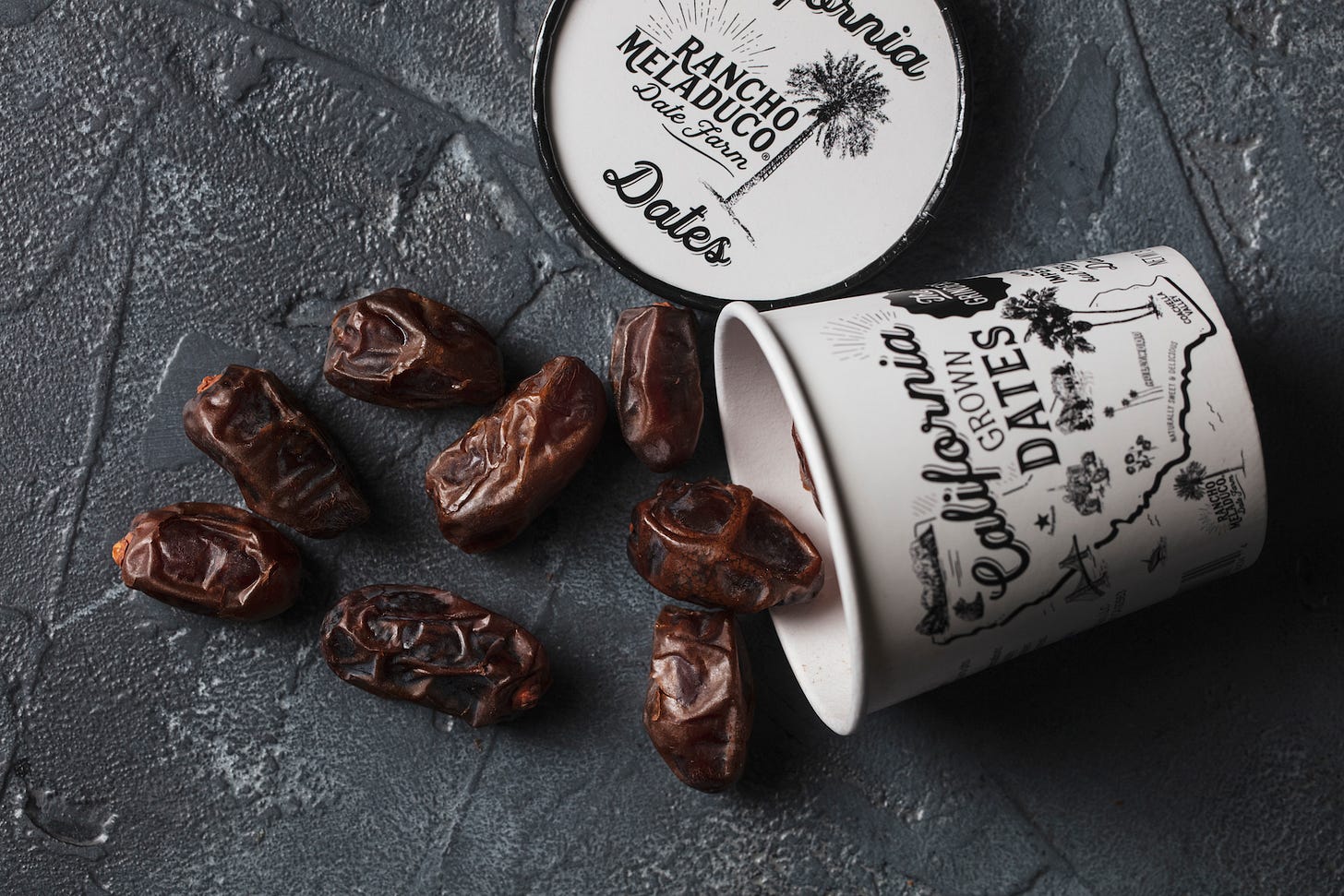
SS: Is there anything else you want people to know about dates?
JS: I am so proud to be a part of the U.S. Date industry and for my role as an innovator who has hopefully helped our industry sell more dates more profitably, and garnered more appreciation for this delicious superfood. We are a small community of farmers and most of us know each other. Dates did not have the cachet they do now, and I’m thrilled we helped change that. They are wonderful, delicious, and nutritious, and grown at great expense and effort in some pretty hot and difficult conditions. I’m so excited to grow our farm, cultivate more varieties, and continue to be an innovator and ambassador for our industry and this amazing fruit, and contribute delicious recipes, engaging content, and storytelling about dates. I hope that more and more people discover dates, eat them regularly, and share them with friends.
Lemon-Thyme Scones with Medjool Dates
Recipe and photo by Julia Heffelfinger
Makes 8 Large Scones
These tender, flaky scones are scented with fresh thyme and lemon zest and studded with sweet Medjool dates. They’re a lovely bite to go with your morning tea, or served alongside a weekend brunch spread. For layered, crumbly scones, there are two important rules to follow: keep your ingredients cold and work your dough as little as possible. In this recipe, I call for frozen butter grated on a box grater. This is an easy way to incorporate the butter into the flour with minimal handling. While you may be tempted to reach for your food processor for this recipe, use your hands or a pastry cutter so you don’t overwork your dough. Overhandling the dough will give you dense scones. Before baking, I pop the dough back in the fridge or freezer until it is very cold. Cold butter creates steam which gives you those coveted flaky layers.
Scones:
2 cups all-purpose flour, plus more for dusting
2 ½ teaspoons baking powder
1/2 teaspoon kosher salt
1/2 cup (1 stick) frozen unsalted butter, grated on a box grater
1 cup pitted and chopped Rancho Meladuco Medjool dates (about 6 large dates)
2 teaspoons fresh thyme leaves, plus more for garnish
1/2 cup light brown sugar
1 large egg
1 ½ teaspoons vanilla extract
1 tablespoon fresh lemon zest
1/2 cup plus 2 tablespoons cold heavy cream
Demerara sugar, for sprinkling (optional)
Icing:
1 cup confectioners’ sugar
1 tablespoon fresh lemon zest, plus 1 tablespoon fresh lemon juice
Pinch of kosher salt
5 tablespoons heavy cream or water, plus more as needed
Make the Scones: In a large bowl, whisk the flour with the baking powder and salt. Scatter the grated frozen butter over the top and work in with a cutter or your fingers until the butter forms pea-size pieces. Add the dates and thyme and gently toss to coat in the flour.
In a medium bowl, whisk the brown sugar with the egg, vanilla extract, lemon zest and ½ cup of the cream. Create a well in the dry ingredients and add the wet ingredients. Using your hands, mix until the scone dough just comes together and everything is evenly moistened.
Dust your work surface with flour, then dump out the scone dough. Press the dough into an 8-inch circle, about 1-inch thick. If your dough is too sticky, sprinkle it with more flour. Wrap the scone disc tightly with plastic wrap and refrigerate for at least 1 hour and up to overnight.
When you’re ready to bake, preheat the oven to 400°F and line a large rimmed baking sheet with parchment paper.
Remove the scone disc from the refrigerator and discard the plastic wrap. Cut into 8 wedges and arrange on the prepared baking sheet. Brush the tops with the remaining 2 tablespoons of cream and sprinkle with demerara sugar. If needed, return your scones to the refrigerator while your oven preheats. You want the dough to be very cold when it goes in the oven. Bake the scones for 20 to 25 minutes, or until golden brown on top and around the edges. Transfer to a wire rack and let cool completely.
Meanwhile, make the icing: In a small bowl, whisk all of the ingredients together, adding the cream 1 tablespoon at a time, until smooth.
Drizzle the icing over the scones and garnish with more fresh thyme leaves. Enjoy!
MAKE AHEAD: This recipe can be prepared through step 3 and stored in the freezer for up to 1 month. When ready to bake, remove the scone dough from the freezer and let sit at room temperature for 10 to 15 minutes before slicing and baking. The baked scones can be stored in an airtight container at room temperature for up to 1 week.
A Few Notes:
Here is my rendition of these delicious scones! A few takeaways and tweaks I made:
I left out the thyme, because I didn’t have any!
I made them in one piece, similar to Irish soda bread, opting to lightly score the tops but not cut them apart so they wouldn’t dry out so much. I cut them into wedges while they were still warm.
Instead of using the icing, I sprinkled some raw sugar on top to give them a little crunch.
These were very delicious and froze very well. They smelled incredible while baking.
Editor: Molly Ramsey
This giveaway is open to residents of the 50 United States and the District of Columbia, 18 years old or older. No purchase necessary. All federal, state, and local regulations apply. Limit one entry per person. Void where prohibited or restricted.

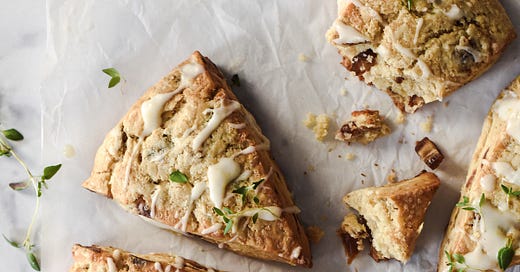



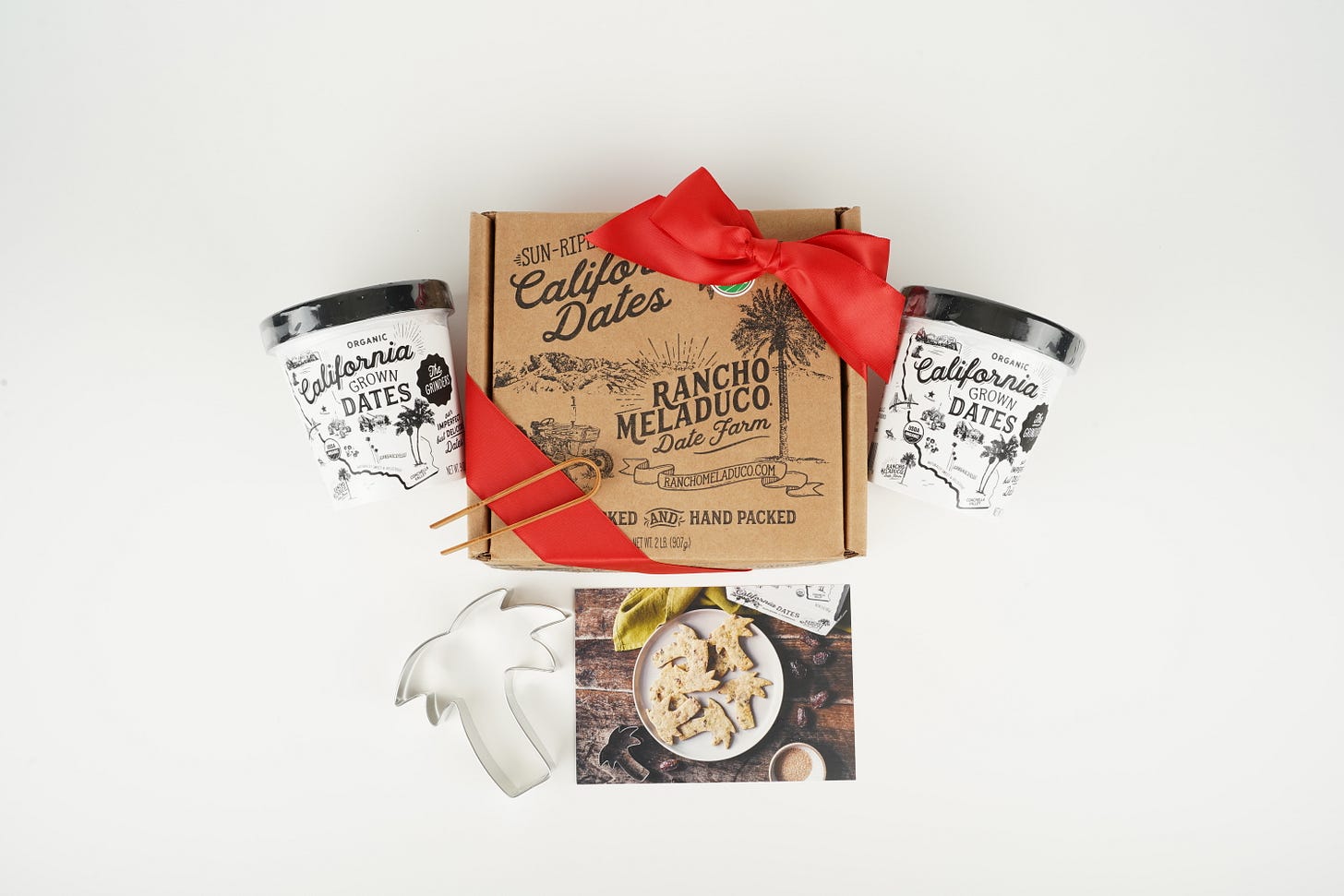




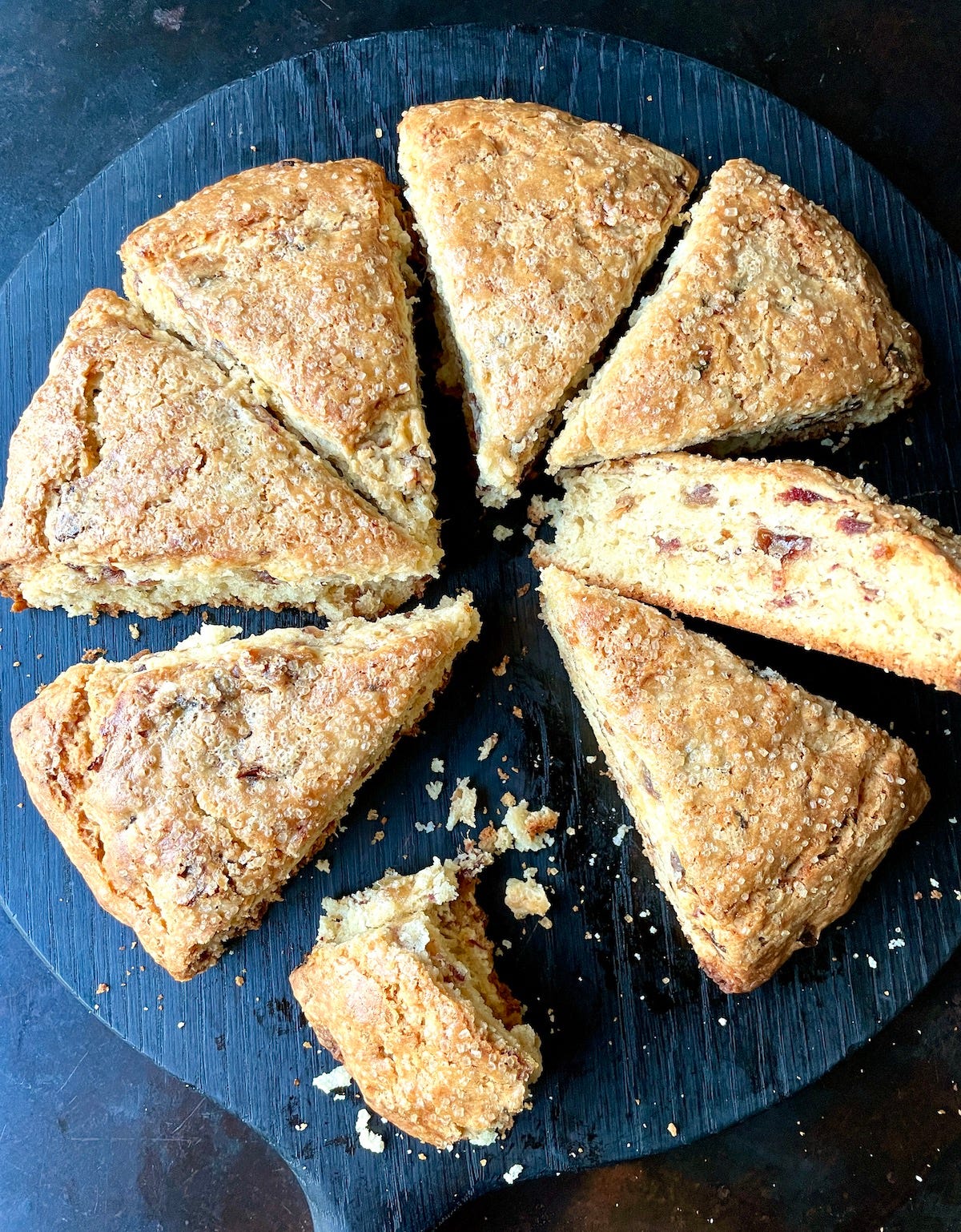
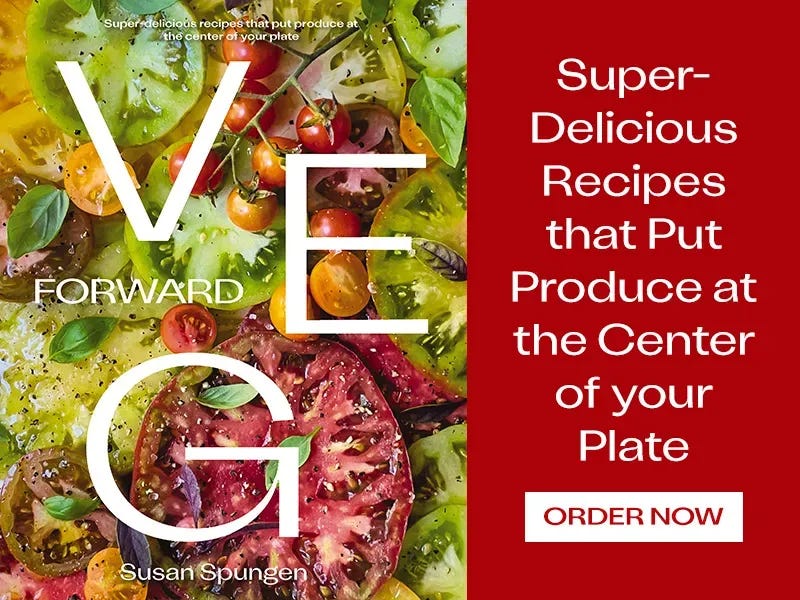
To make a healthier version of snickers — dates stuffed with almond butter, dunked in warm chocolate and rolled in Maldon salt. Yummmm
I'd like to win so I can experience what great date should be! My feelings on dates have been mixed through the years - I've had amazing ones, and not-so-amazing ones. I want to set the bar for great dates.